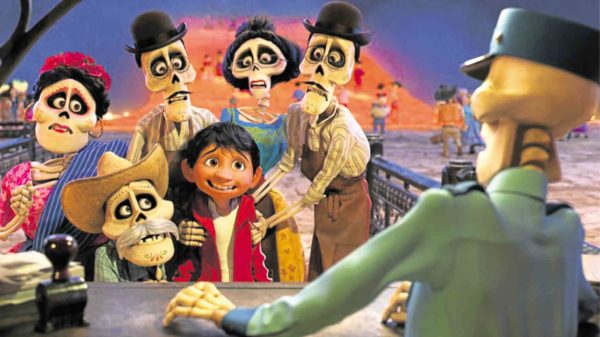
“Coco”
Most American animated feature films are set in the good, old US of A, and tell stories that W.A.S.P.s can delightedly relate to.
In more recent film seasons, however, more movies for the kiddie and family audience have been made that vivify foreign cultures and ways of life—a more expansive and all-embracing move that should go a long way in making viewers less parochial and insular, and willing to understand and empathize with people who look and behave differently from them.
The latest full-length animation in this regard is “Coco,” which for the first time makes Mexico’s traditional Dia de los Muertos interesting and instructive for viewers all over the world.
This is the Mexican version of our own “Undas,” or All Souls and All Saints annual observance—but, going in the opposite direction: On Undas days, the living go to cemeteries to honor the dead—but, on Dia de los Muertos, it’s the dear departed who come to visit!
“Coco’s” specific story is about a young boy, Miguel, who loves music, but is forbidden by his family to pursue his passion, because his great-grandmother’s father, a famous Mexican singing star, left them high and dry many years ago to achieve his dream of becoming the country’s top singing sensation.
On Dia de los Muertos, however, Miguel has the chance to reconnect with his controversial relative, despite his family’s interdictions, and thus attain his dream of making music his reason for living.
However, it turns out to be a dauntingly difficult reconnection to achieve, because there are all sorts of traditional rules that have been put in place to make sure that the dead’s visit with the living is restricted to only one encounter a year—otherwise, all heck and even Hell could break loose!
The film’s traditional “flavor” makes it look exotic and visually colorful and beguiling, and its songs’ Latin tempi add to its unique appeal.
Also, quite unexpectedly, its storytelling has plot twists that take it in unpredictable directions, with heroes being unmasked as villains later in the cinematic unfolding—and, the other way around.
All these beauties and bounties make for an exhilarating viewing experience, and the antic participation of Miguel’s visiting dear departed enables it to even go surreal at times, further ramping up its yummy “scare tactics.”
On the debit side, the film is occasionally too visually rich and lush, with musical performance sequences that open up the scope and action to excess.
This results in blurred details that make it harder for viewers to relate personally to its core storytelling, and its young protagonist’s complicating quest for happiness, familial connection and the freedom to express himself artistically, as he desperately desires.
All told, however, “Coco” hits the right notes and uses its exoticism well to induce and seduce viewers into empathizing with a story and culture different from theirs.
After “Moana,” “Mulan” and now “Coco,” young viewers should have an easier time understanding people different from themselves—unlike their parents and grandparents, who were exposed to less enlightened and thus less enlightening entertainment.

